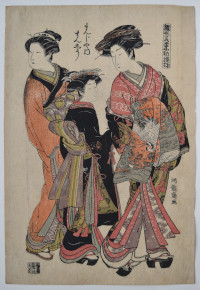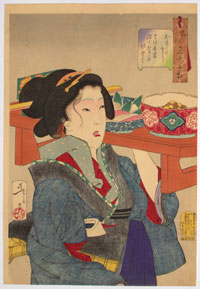Isoda KORYUSAI (1735-1790)

Click here to view image full size.
Manjiya uchi Manshiu, “Manshiu of the Manjiya [Brothel or House]” from a set: Hinagata wakana no hatsu moyo, “New Year Designs as Fresh as Young Leaves.” One of the great 18th century sets comprising at least 140 prints of consistent quality throughout. Shows the oiran with her two kamuro. Published in the late 1770s by Eijudo with some designs by Juzaburo.
Fine impression and colour. Slight creasing, otherwise very good condition. On heavy hosho. Signed Koryusai ga.
Status: Sold
Kitao MASANOBU (Santo KYODEN) (1761-1816)

Click here to view image full size.
One double-oban design from the most sumptuous album ever produced: Yoshiwara keisei: Shin bijin awase jihitsu kagami, “A Mirror of New Yoshiwara Courtesans with Samples of Their Calligraphy.” Published by Tsutaya Juzaburo, 1784. Shows courtesans viewing calligraphic scrolls. Seven double-oban designs were published in album form, although the original intention was for a larger set. Signed on two sheets Kitao sensai Masanobu.
Fine impression and colour. Centre fold (as always), otherwise very good condition.
Status: Sold
Kikugawa EIZAN (1787-1867)

Click here to view image full size.
A triptych Furyu onna ryoushi, “Fashionable Fishing Women.” Shows beauties on the seashore collecting fish and loading them onto a boat for market. In the background, fishermen with nets. Published by Iwatoya Kisaburo (Eirindo), c 1817. The Japanese love seafood and, being surrounded by water, there is an abundance of fish and crustaceans as anyone who has visited the central fish market in Tokyo can attest to.
Fine impression. Very good colour. Small areas of expertly repaired wormholes, otherwise very good condition. Signed Eizan hitsu.
Status: Sold
Keisai EISEN (1790-1848)

Click here to view image full size.
A triptych showing three courtesans from the Tamaya House: On first sheet Koyuki playing the kokyu; on the second Hanamurasaki playing the koto; and on the third Hanakazura playing the shamisen. Published c 1830.
Fine impression with excellent colour. Some expert edge restoration, otherwise very good condition with extra paper around.
Status: Sold
Tsukioka YOSHITOSHI (1839-1892)
Click here to view image full size.
“Looking Weighed-down: The Appearance of a Waitress at Fukagawa in the Tempo Era” ( 1830 – 1844 ). From the set: Thirty-two Aspects of Women published by Tsunashima Kamekichi, 1888. The waitress is shown carrying a tray of rice, sashimi and beans.
Very fine impression and colour of the first edition. A mulberry fibre towards top edge, otherwise very fine condition with margins intact. ( These thread-like filaments of the tree sometimes survived the pulping process – either minute pieces of the outer or inner bark and are often seen. ) Signed Yoshitoshi ga.
Status: Available
